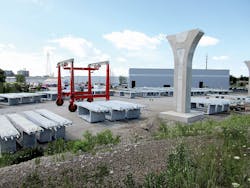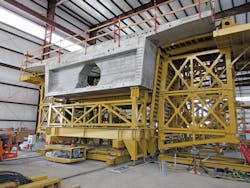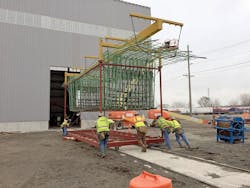Construction of the new Cline Avenue Bridge over Indiana Harbor and Ship Canal, East Chicago, Ind.
The New Cline Avenue Bridge is an elevated expressway in Northwest Indiana that connects SH 912 to I-90, crossing over the Indiana Harbor and Ship Canal in East Chicago, Ind.
This connection on the eastern side of the Chicago metropolitan region accommodates significant interstate truck traffic and provides a vital link to important commercial industries and employment centers along the Lake Michigan shoreline. The new bridge replaces a structurally deficient bridge that was closed in November 2009 and then demolished by the Indiana DOT. At the time, approximately 35,000 vehicles per day were using the bridge.
Since traditional state funding was not available to replace the bridge, the design, construction, operation and maintenance of this new bridge is privately funded without using any federal, state or local tax dollars. The replacement bridge will be supported by user fees (tolls), and is configured to accommodate current and future traffic. The bridge is positioned in the existing right-of-way with room to build a future twin bridge when warranted by traffic growth. A modern all-electronic open-road tolling system will create a user-friendly experience for bridge travelers.
The New Cline Avenue Bridge construction uses local materials and local union labor which enhances economic opportunities in the area. The construction provides over 300 local jobs. Transportation will be improved in Northwest Indiana while achieving environmental stewardship with features such as sustainable concrete materials, long open spans and low energy LED lighting.
The segment reinforcement cages are pre-tied in temporary jigs outside the precast building and pushed on carts inside along an innovative rail system.
Construction of the bridge started on July 10, 2017, and is scheduled for completion in January 2020. The bridge is 6,236 ft long with a 316 ft main span over the Indiana Harbor and Ship Canal, providing 100 ft of vertical and 200 ft of horizontal navigational clearance. The superstructure is composed of sustainable post-tensioned concrete single-cell box girders designed with low-maintenance features for a 150-year service life. The overall project is 9,850 ft long, which includes connecting the new concrete segmental bridge with a 2,400-ft-long adjacent existing steel beam bridge with construction rehabilitation being achieved concurrently.
The New Cline Avenue Bridge is comprised of 29 spans and 28 piers, with typical spans that vary between 170 ft to 290 ft. The piers vary in height from 24 ft to 86 ft. The substructure is founded on 16-in.-diam. open-end steel pipe piles. The top 20 ft of the pipe piles are filled with cast-in-place concrete and doweled into the footings. As an environmentally sensitive feature, the footings were placed mostly above ground with an attractive shape in order to avoid dewatering with a high-water table over land and not disturb the underlying soils. The webs of the trapezoidal superstructure cross-section taper down to a narrow width at the top of the pier cap to allow an elegant aesthetically shaped pier. The tapering pier shapes also include an inset reveal that will be stained with blue to enhance the overall attractive draw of development and users to the bridge.
The superstructure is 46 ft wide at deck level to accommodate two 12-ft lanes with 9-ft shoulders. The precast box girder varies in depth from 9 ft to 14 ft with 16 constant-depth spans and 13 variable-depth spans. Because the pier locations and spans were designed to coincide with the previous bridge piers, the end span lengths of the resulting units require mid-span expansion joints. There are three mid-span expansion joint locations along the bridge that include large structural steel expansion beams that slide on elastomeric bearings within the core of the adjacent cantilever ends of the box girders.
The precast box girder segments are cast with a custom-designed concrete mix that provides a high-strength, low-permeability (< 1,000 coulombs) superstructure. The superstructure is biaxially compressed with transverse and longitudinal tendons along the span to provide redundancy and durability. The deck includes extra thickness that is precast with the segments to provide an integral wearing surface that uses high-strength concrete cured in a factory-quality setting.
There are four total casting cells on the Cline Avenue Bridge project. Three cells are used to cast typical box girder segments inside a casting building that was erected for the project.
Working together
The bridge design and construction has progressed through significant stakeholder coordination for local CN and IHB Railroads, City of East Chicago building permits, Indiana DOT adjacent roadway connections, Federal Aviation Administration (given close proximity to the Gary, Ind., airport), Indiana Department of Natural Resources, Indiana Department of Environmental Management, State Historic Preservation Office, U.S. Coast Guard and U.S. Army Corps of Engineers, and local electric and gas service utilities.
The precast superstructure segments are cast in a yard located on the Cline Avenue Bridge property. There are four total casting cells on the project. Three cells are used to cast typical box girder segments inside an 82-ft-wide by 300-ft-long by 58-ft-high casting building that was erected for the project. This has allowed segment casting to continue throughout the winter in Northwest Indiana. A fourth cell is located outside the building for casting the heavier pier segments, which are not affected by the schedule. The segment reinforcement cages are pre-tied in temporary jigs outside the building and pushed on carts into the building along an innovative rail system. Overhead cranes inside the building lift and set the cages into the forms in the casting beds. The segments are match-cast to each other, and then individually rolled out of the building and transported into storage with a yard straddle crane until needed for span erection. The segment production goal is to precast one segment in each bed every day, and this rate of erection has been regularly achieved. There is a total of 685 segments for the project that weigh between 65-90 tons each. As of February 2019, 60% of the segments had been precast and placed into storage. Superstructure segment erection started in March 2019.
Assembly of the bridge superstructure represents the final major step in the construction schedule and is performed using the balanced cantilever method of precast segment erection. For this method, FIGG Bridge Builders (FIGG) designed, fabricated and assembled temporary structural steel towers around the permanent piers to support the superstructure pier segments and typical segments during cantilever construction. Adjacent cantilevers are erected outward from the piers until they are within approximately 4 ft of each other at mid-span where a cast-in-place closure is placed and continuity tendons stressed across the joint to complete the spans. There are 28 cantilevers and 28 closure joint pours between cantilevers to complete the entire bridge. The spans are easily accessed for erecting segments with ground-based cranes. Erection is being performed at two headings using two separate large-capacity cranes to lift and set the cantilever segments. Only one 316-ft span will need to be erected with marine operations over the Indiana Harbor and Ship Canal. Approximately one-half of the segments are delivered to the cranes by the straddle lift on the west side of the project. Once erection progresses across the canal, the remaining precast segments will be transported to the other side of the canal to complete erection of eastside spans and connect the New Cline Avenue Bridge to the adjacent existing steel-beam bridge.
A casting bed inside the precast building is used for constant-depth segment casting.
Innovation
One advanced technique being used for quality control by the project team is concrete maturity sensors to monitor the curing of cast-in-place footings and precast superstructure segments. The maturity sensors were initially calibrated with concrete test cylinders until the sensors then became the mechanism for determining when forms could be stripped, segments moved in the beds and transverse post-tensioning stressed. They also provide a record of temperature gains while the concrete is hydrating. These sensors offer added value with an opportunity to evaluate long-term strength gain of the bridge as a reference for future load-rating and transporting special overload trucks.
FIGG serves as the engineer-procure-construct (EPC) general contractor and performed project design. FIGG services include performing quality control of the constructed bridge, while quality assurance is provided with independent testing facilities. Local engineering subconsultants have been engaged for roadway design, material testing and construction survey services. Superstructure precasting is performed by Cline Precast LLC, a FIGG subsidiary. Substructure construction has been performed by Kenny Construction. Superstructure erection is performed by McLean Contracting Company. All the principal contractors and subcontractors are using local union subcontractors to provide specialty labor resources. The bridge concrete, reinforcement and supporting materials are provided by local suppliers.
The bridge has continued to generate an increasing level of public interest and excitement. The community of future bridge users and neighbors have been engaged by the construction team through site tours, presentations and a planned series of “Saturday Talks” at the project office. This is an opportunity to share bridge construction progress with the interested public in a safe, protected viewing area where substructure, segment precasting and superstructure erection can all be seen from one convenient location. The community visitors and other site guests enjoy signing their names and messages inside the box girder segments while they are stored on the grounds near the project office. This personalizes their presence in the historical moment of this important transportation connection. When traffic reconnects on this major state highway in 2020 for better transportation to work, recreation, movement of goods and services, and time savings, people will see a catalyst to advancing the quality of life throughout the region.
Crews rolling a typical reinforcement cage into building for precast superstructure segments.




